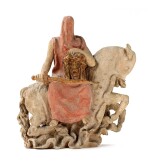
ALFRED AUGUSTE JANNIOT | MELPOMÈNE, CIRCA 1940 - 1945
Lot Closed
July 23, 01:56 PM GMT
Estimate
15,000 - 25,000 EUR
Lot Details
Description
ALFRED AUGUSTE JANNIOT
1889 - 1969
MELPOMÈNE, CIRCA 1940 - 1945
polychrome earthenware
signed A.Janniot on the reverse and titled MELPOMENE on the horse
---------------------------------------------------------------------------
MELPOMÈNE, CIRCA 1940 - 1945
terre cuite polychrome
signé A.Janniot au revers et titré MELPOMENE sur le cheval
hauteur : 45 cm ; 17 3/4 in. ; height : 45 cm ; 17 3/4 in.
Due to the various measures taken to deal with the Covid-19 epidemic, property collection and shipment of this lot will be delayed until the offices where it is located are able to reopen. Please refer to the “auction details” tab. Thank you for your understanding
Please contact FRpostsaleservices@sothebys.com for any shipping inquiries.
[En raison des circonstances actuelles liées au COVID-19, la livraison de ce lot ne pourra intervenir qu’après la réouverture des locaux de Sotheby’s dans lesquels il se trouve. Nous vous remercions de votre compréhension et nous vous invitons à consulter l’onglet « auction details ».
Pour toute demande concernant le transport, veuillez contacter FRpostsaleservices@sothebys.com.]
Michel Giraud, Alfred Janniot, Paris, 2006, p. 121
Michel Giraud, Alfred Janniot, Paris, 2006, p. 121
Alfred Auguste Janniot (1889-1969) trained as a sculptor at the Ecole des Beaux-Arts. He won the Prix de Rome in 1919, which rewarded his work on a historical subject, taken from Antiquity or Greco-Roman mythology. Influenced by his stay in Rome, the cradle of Antiquity, around 1940-1945 he created this terracotta sculpture representing Melpomene, the muse of song and tragedy. Several traditional symbols stand out from this sculpture: the muse is veiled and holds a Medusa mask and a sword.
---------------------------------------------------------------------------
Alfred Auguste Janniot (1889-1969) suit une formation de statuaire à l’Ecole des Beaux-Arts. Il gagne le Prix de Rome en 1919, qui récompense son travail sur un sujet historique emprunté notamment à l’histoire antique ou la mythologie gréco-romaine. Influencé par son séjour à Rome, berceau de l’Antiquité, il réalise vers 1940-1945 cette sculpture en terre-cuite représentant Melpomène, la muse du Chant et de la Tragédie. Plusieurs symboles traditionnels ressortent de cette sculpture : la muse est voilée et tient un masque de Méduse et une épée.
